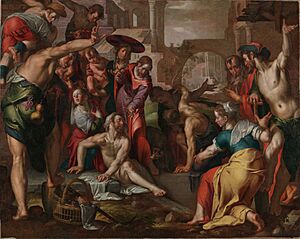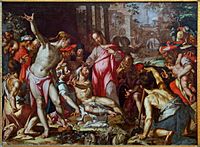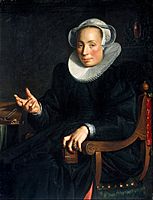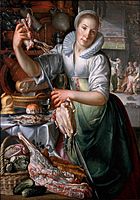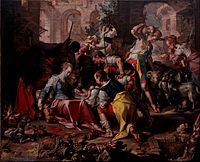Joachim Wtewael facts for kids
Quick facts for kids
Joachim Wtewael
|
|
|---|---|
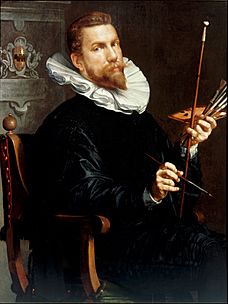
Self-portrait, 1601
|
|
| Born |
1566 |
| Died | 1 August 1638 (aged 71–72) |
| Nationality | Dutch |
| Known for | Oil painting |
|
Notable work
|
Perseus and Andromeda, Louvre, small paintings on copper |
| Movement | Northern Mannerism |
Joachim Anthoniszoon Wtewael (born in 1566 – died August 1, 1638) was a famous Dutch painter. He was known for his unique style called Northern Mannerism. Wtewael was also a very successful flax merchant and a town council member in Utrecht.
His paintings are special because they show figures that are drawn very well. These figures often have interesting or unusual poses. Even though new art styles were appearing, Wtewael kept his own distinctive way of painting.
Contents
Who was Joachim Wtewael?
Joachim Wtewael was a leading artist of the Northern Mannerism style in the Netherlands. He learned this style in Haarlem in the late 1500s. He continued to paint in this way even during the early Dutch Golden Age.
He created about one hundred paintings, along with drawings and designs for stained glass. He made both large paintings on canvas and tiny ones on copper plates. The small copper paintings are often considered his most unique works.
What did Wtewael paint?
Wtewael often painted the same subjects many times, but he changed the way he showed them. Some of his favorite topics included:
- The Adoration of the Shepherds
- Venus and Mars Surprised by Vulcan
- The Feast of the Gods (like the wedding feasts of Cupid and Psyche, or Peleus and Thetis)
- The Judgement of Paris
- Lot and His Daughters
He also brought back "kitchen scene" paintings, which showed everyday life in kitchens. These were similar to works by Pieter Aertsen from fifty years earlier. When his small paintings are well-preserved, they "glow like gems."
Wtewael's other work and life
Wtewael was very wealthy from his flax business. Flax is a plant used to make linen and canvas. This business likely took up a lot of his time. However, he was also famous as a painter during his lifetime. His reputation reached as far as Prague.
His large house in Utrecht is still there today, though it has been changed. The Utrecht museum has some of his family portraits and two beautiful pieces of his furniture. He had several children. It seems he stopped painting for almost the last ten years of his life. This might have been because his wife became ill and passed away.
Like his brother, Wtewael was a city council member. He was also involved in religious discussions as a member of the main Dutch Reformed Church. His most famous and largest painting is Perseus and Andromeda, which is almost life-size and can be seen in the Louvre museum.
Creating his very detailed small paintings probably wasn't very profitable. But since he had plenty of money, he likely painted for his own enjoyment and to gain fame. In 1669, his granddaughter still owned 30 of his paintings.
Recent interest in Wtewael's art
In recent years, there has been more interest in Wtewael's art. From 2015 to 2016, the first big exhibition just for his work was held. It was called Pleasure and Piety: The Art of Joachim Wtewael (1566–1638). This show traveled to Utrecht, Washington D.C., and Houston, Texas.
Wtewael's Life Journey
Wtewael was born and spent almost all his life in Utrecht, where he also passed away. His father was a glassmaker and glass painter who moved to Utrecht in 1566.
Early career and travels
Wtewael started his career in his father's workshop. He worked as a glassmaker and glass engraver. In 1586, he began a four-year journey. He traveled and lived in Italy and then France. In France, he stayed with the bishop of St Malo. His main base in Italy was in Padua, near Venice. His earliest works show that he knew about the Second School of Fontainebleau, which he probably visited.
Returning to Utrecht
Around 1590 (or by 1592 at the latest), Wtewael came back to Utrecht. He opened his own workshop and joined the saddlemakers' guild. In Utrecht, this guild also included painters. He started making paintings, drawings, engravings, and stained glass. Later, he helped start the new Utrecht Guild of Saint Luke for painters. He never lived anywhere else and never traveled outside the Netherlands again.
A person from Utrecht who knew Wtewael well also praised his skill in sculpture. However, no clear examples of his sculptures are known today.
Family life
Wtewael married Christina Wtewael van Halen (1568–1629). His self-portrait from 1601 goes with a portrait he painted of her. In 1596, they had a son named Peter Wtewael, who also became a painter. Their other son, Jan (1598–1652), might have been a painter too. He registered with the guild in 1639 after his father died.
A visitor to Utrecht in 1626, Joachim von Sandrart, noted that Peter and his father seemed to focus more on their flax business than on painting. In the portraits Joachim painted of his two sons, Peter is shown as a painter and Jan as a "humanist," holding a book. Peter became a wealthy man and remodeled the family house in 1639, the year after his father died.
In the late 1620s, Joachim painted portraits of both his sons (dated 1628). He also painted his daughter Eva (1607–1635) and a pair of portraits of his other daughter and her husband Johan Pater (dated 1626). All these paintings are in Utrecht. Records suggest that several other children died young, but their birth dates are not known. Wtewael's dated paintings range from 1592 to 1628, covering his life from age 26 to 62.
Public service
Wtewael was on the town council in 1610. Later, the Stadtholder Maurice, Prince of Orange gave him a lifelong seat on the council. This was for his loyalty against a group called the Remonstrants. However, his brother also received this honor, and Utrecht had a rule that only one brother could be on the council at a time. So, Wtewael did not take his seat until 1632, after his brother had passed away.
Where to see Wtewael's art?
The largest collection of Wtewael's work is at the Centraal Museum in Utrecht. This collection includes a self-portrait from 1601 and several other family portraits. These works stayed in the family until recent decades. Many other museums in the Netherlands, Germany, Britain, and America also have his paintings. However, many of his works are still in private collections.
Online collections
You can view some large, zoomable images of his paintings online:
- Mars and Venus Surprised by Vulcan, painted around 1606–1610, at the Getty Museum, Malibu.
- The Holy Family with Saints and Angels, painted around 1606–1610, at the Museo Thyssen-Bornemisza, Madrid.
- The Judgement of Paris, painted in 1615, at the National Gallery, London.
Gallery
Large paintings
-
Raising of Lazarus, about 1600, his largest painting.
-
His daughter Eva Wtewael (1607-1635), 1628, shown needleworking.
-
Bacchus, about 1628, one of his last works.
Smaller paintings
See also
 In Spanish: Joachim Wtewael para niños
In Spanish: Joachim Wtewael para niños
- City of Gotha and Federal Republic of Germany v. Sotheby's and Cobert Finance S.A.


